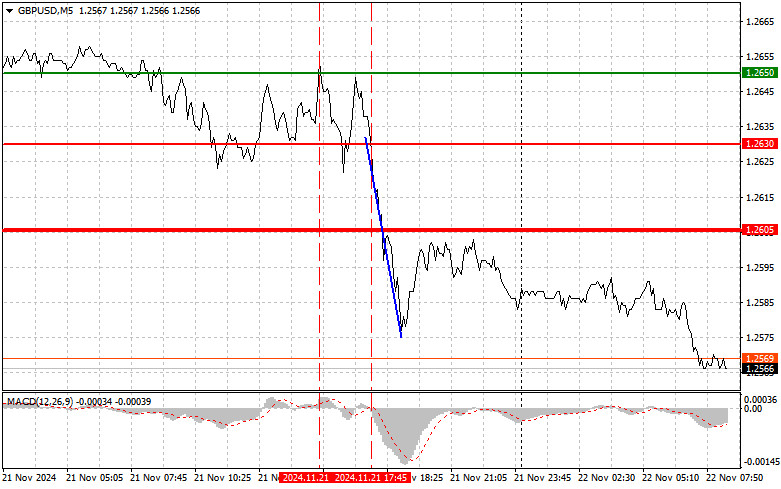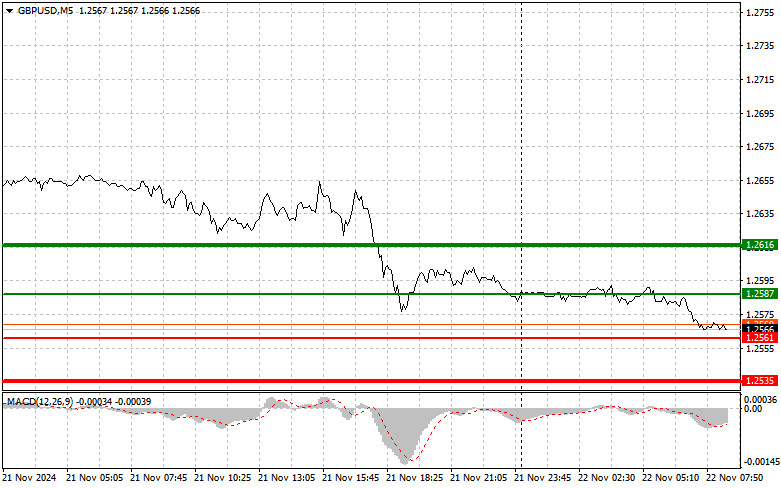Analysis of Trades and Trading Recommendations for the British Pound
The test of the 1.2650 price level coincided with the MACD indicator being significantly above the zero mark, which limited the pair's upward potential. For this reason, I refrained from buying the pound. Closer to the middle of the US session, the test of the 1.2630 price level occurred as the MACD indicator began to move down from the zero mark, allowing me to sell the pound and achieve a substantial decline of over 60 pips.
With the US dollar continuing to strengthen, the British pound is vulnerable. Market participants closely monitor the Bank of England's actions as it considers maintaining rates at current levels despite economic challenges. However, with rising inflation and economic uncertainty, the question remains whether the central bank can manage this situation without additional easing measures. Additionally, concerns about global economic stability are increasing pressure on the pound. The strengthening dollar, driven by demand for safe-haven assets, makes traders more cautious, further exacerbating the situation. The GBP/USD pair remains under pressure, with future fluctuations influenced by UK domestic policies and external factors, including the global economic outlook.
Today, a series of reports will be released, including UK retail sales, the manufacturing PMI, services PMI, and the composite PMI. These reports will shed light on the state of the UK economy amid restrictive monetary policy. Weak data could push the pound even lower. I will focus on Scenario 1 and Scenario 2, which are detailed below for intraday strategies.
Buy Scenarios
Scenario 1:
Plan to buy the pound today at the 1.2587 level (green line on the chart), targeting growth to 1.2616 (thicker green line). Exit purchases at 1.2616 and open sales in the opposite direction, aiming for a 30–35 pip movement from the level. A rise in the pound today can be expected following strong data releases. Important: Before buying, ensure the MACD indicator is above the zero mark and just beginning to rise.
Scenario 2:
Also, plan to buy the pound if the price tests the 1.2561 level twice in a row, with the MACD indicator in the oversold area. This will limit the pair's downward potential and may trigger an upward market reversal. Expect growth to the opposite levels of 1.2587 and 1.2616.
Sell Scenarios
Scenario 1:
Plan to sell the pound today after breaking below the 1.2561 level (red line on the chart), which could lead to a quick decline in the pair. The key target for sellers will be 1.2535, where I plan to exit sales and immediately consider buying in the opposite direction, aiming for a 20–25 pip movement from the level. Selling the pound is preferable at higher levels. Important: Before selling, ensure the MACD indicator is below the zero mark and beginning to decline.
Scenario 2:
Also, plan to sell the pound if the price tests the 1.2587 level twice in a row, with the MACD indicator in the overbought area. This will limit the pair's upward potential and may trigger a downward market reversal. Expect a decline to the opposite levels of 1.2561 and 1.2535.
What's on the Chart:
- Thin green line: Entry price for buying the trading instrument.
- Thick green line: A suggested target for Take Profit or manually locking in profits, as further growth above this level is unlikely.
- Thin red line: Entry price for selling the trading instrument.
- Thick red line: A suggested target for Take Profit or manually locking in profits, as further decline below this level is unlikely.
- MACD Indicator: Critical for identifying overbought and oversold zones to guide market entry decisions.
Important Notes for Beginner Forex Traders:
- Always approach market entry decisions cautiously.
- Avoid trading during major news releases to sidestep volatile price swings.
- If trading during news releases, always set stop-loss orders to minimize losses.
- Trading without stop-loss orders or money management practices can quickly deplete your deposit, especially when using large volumes.
- A clear trading plan, like the one outlined above, is essential for successful trading. Spontaneous trading decisions based on current market conditions are inherently disadvantageous for intraday traders.











